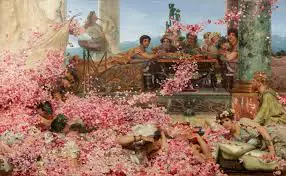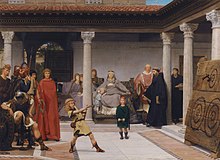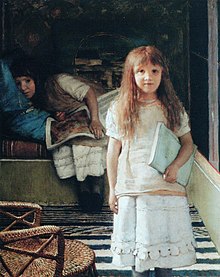Sir Lawrence Alma-Tadema (January 8, 1836 – June 25, 1912) was a rarefied amongst the most eminent Victorian painters generally in nineteenth-century Britain. He was born in Dronrijp, the Netherlands. Sir Lawrence Alma Tadema studied at the Academy of Antwerp in Belgium, later settled in England in 1870. Languorous figures set in astounding marbled insides or against a set of amazing blue Mediterranean ocean and sky was a characteristic of his work.
Origin of Name Tadema
Tadema, (meaning Adam-son), was an old Frisian patronymic ending with the suffix ‘ma’ – ‘son of’ while the names Laurens and Alma belonged to his godfather. Laurens would later change his name to the more English Lawrence, and integrated Alma into his surname so as to have his name show up toward the start of presentation lists, under A as opposed to under T.
Lawrence Alma Tadema’s Learning
It was expected that he as a kid would turn into a legal advisor; yet in 1851 at fifteen years old he endured a physical and mental breakdown. Analysed as destructive; he had a brief timeframe to live. Sir Lawrence Alma Tadema was permitted to spend his remaining days at his recreation, drawing and painting. Left on his own, with time his health improved. Sir Lawrence chose to seek vocation as an artist. In 1852 he entered The Royal Academy of Antwerp where he examined early Dutch and Flemish workmanship, under Egide Charles Gustave Wappers. Amid Alma-Tadema’s four years as an enrolled understudy at the Academy, he won a few respectable honours.

Before leaving school, towards the finish of 1855, he became an accomplice to the painter and teacher Louis (Lodewijk) Jan de Taeye. De Taeye acquainted him with books that affected his longing to depict Merovingian subjects. Sir Lawrence Alma Tadema was urged to detail noteworthy exactness in his artworks, an attribute for which the painter was later known. Merovingian topics were the painter’s most loved subject up to the mid-1860. It is maybe in this arrangement that we discover the artist moved by the most profound inclination and the most grounded soul of sentiment.
Recognition of Lawrence Alma Tadema
After his landing in England, where he was to spend whatever is left of his life, Alma-Tadema’s work was one of proceeded progress. He ended up a standout amongst the most well-known and generously compensated craftsmen of his times, recognized and remunerated. By 1871 Sir Lawrence Alma Tadema had met and become friends with the greater part of the major Pre-Raphaelite painters and it was to some degree because of their impact that the craftsman lit up his palette, differed his tints, and helped his brushwork.
Lawrence Alma Tadema’s famous works
One of his most well-known artistic creations is The Roses of Heliogabalus (1888) – in view of a scene from the life of the notoriously defiled Roman Emperor Elagabalus (Heliogabalus), the work of art delineates the psychopathic Emperor choking out his visitor at a blow out under a course of flower petals. The blooms described were sent week after week to the painter’s London studio from the Riviera for four months amid the winter of 1887 – 1888.

Among Alma-Tadema’s works of this period are An Earthly Paradise (1891), Unconscious Rivals (1893) Spring (1894), The Coliseum (1896) and The Baths of Caracalla (1899). Despite the fact that Alma-Tadema’s distinction lays on his sketches set in Antiquity, he likewise painted representations, scenes and watercolours, and made a few etchings himself (albeit numerous more were made of his works of art by others).
Last days of Lawrence Alma Tadema
His last real piece was Preparation in the Coliseum (1912). In the late spring of 1912, Alma Tadema was joined by his little girl Anna to Kaiserhof Spa, Wiesbaden, Germany where he was to experience treatment for ulceration of the stomach. Sir Lawrence Alma Tadema on June 28 1912, at the age of seventy-six passed away in St. Paul’s Cathedral in London.

He received all around appreciation for his sublime portrayals of classical vestige, amid his lifetime, he fell into unsavoriness after his demise and just over the most recent thirty years has his work been reconsidered for its significance inside nineteenth-century English workmanship.